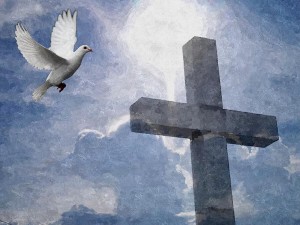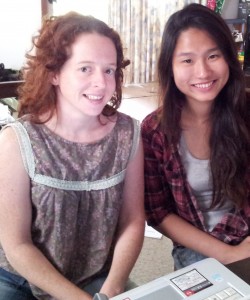It’s been a couple of weeks since Pam and I (and Jon, Pam’s friend) returned from our trip to Japan to say hi to our clients and friends. We had a very enjoyable, if hectic, time. We combined business with play. Pam managed to fit in a friend’s wedding and I caught up with friends I hadn’t seen since my undergrad student days, fifteen years ago.
We arrived in Osaka on the evening of the Thursday April 5 and caught a bus to Kobe where we split up. Jon and I stayed at Pam’s friend (and now our friend) Louise’s place in Okamoto, and Pam stayed at Mike and Michiko’s in Rokko. Kobe is a beautiful city with lots of quaint laneways bursting with trendy and sophisticated boutiques, wine bars and restaurants. There’s a quiet hum of activity here, quite different to Osaka or the manic Tokyo. Louise very kindly took us to a lovely Sushi bar for dinner once we’d arrived. After a long day of travel, the beer and sushi went down a treat.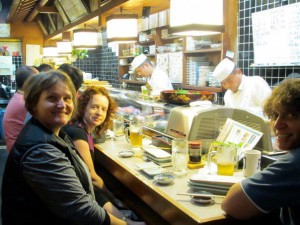
On Friday, Pam, Jon and I made our way to Sannomiya, where Pam and I had coffee with Tokunaga san from Osaka STA. We came out of that conversation with some new ideas – Tokunaga-san put us onto a possible new market. Watch this space for further developments as Pam and I think about how to proceed. It’s always nice to have new ideas, but a challenge coming up with concrete plans to put them into action. Pam likes a challenge, though 😉
It was much colder than we had anticipated—it was a maximum of 9 the day after we arrived. My wardrobe was totally unprepared for extreme cold, so I had no choice but to go shopping. I know, it’s a tough life, right? I got a gorgeous coat from a funky second-hand clothing store, Orange Thrifty, recommended by Louise.
The following day I went to hanami with an old friend, while Pam and Jon made their way to Shik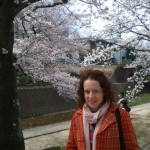 oku to also do some catching up with friends. I eventually found my way down to Miyazaki, in Southern Kyushu. My purpose going there was to pay a visit to Minami Kyushu Junior College,client that ARET has been working with for several years.
oku to also do some catching up with friends. I eventually found my way down to Miyazaki, in Southern Kyushu. My purpose going there was to pay a visit to Minami Kyushu Junior College,client that ARET has been working with for several years.
Miyazaki is a strange place. I knew very little about it before arriving, but on first appearance it looked like a town with a lot of big empty hotels, so I thought that maybe it used to be a popular tourist destination. I soon discovered that’s exactly what it was. Sixty years ago, Miyazaki was the primary destination for the majority of Japanese honeymooners. It’s on the beach, it’s warm – I guess as far as tropical destinations go in Japan, after Okinawa, Miyazki is the ticket! It certainly was lovely and warm—a massive change from the cold we had in Kobe.
These days, Miyazaki is a holiday destination for Chinese and Korean tourists, but 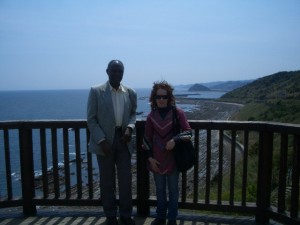 while I was there, it was pretty deserted, and pretty depressing. I wasn’t sad to say goodbye to Miyazaki, although I must admit the hotel I stayed in, Miyazaki Hotel, was lovely . My room was one of the biggest hotel rooms I’ve ever been in, and this is Japan, the land of tiny hotel rooms! Even the bathroom was enormous! I also had a delicious meal in Miyazaki, maybe one of the best I had in the whole 2 weeks I spent in Japan. Vegetable gyoza, hiyakko and potato salad. Simple, very reasonably priced and absolutely delicious.
while I was there, it was pretty deserted, and pretty depressing. I wasn’t sad to say goodbye to Miyazaki, although I must admit the hotel I stayed in, Miyazaki Hotel, was lovely . My room was one of the biggest hotel rooms I’ve ever been in, and this is Japan, the land of tiny hotel rooms! Even the bathroom was enormous! I also had a delicious meal in Miyazaki, maybe one of the best I had in the whole 2 weeks I spent in Japan. Vegetable gyoza, hiyakko and potato salad. Simple, very reasonably priced and absolutely delicious.
I flew to Tokyo on Tuesday 10 April and went straight to hanami at Yasukuni Jinja, with a friend and her colleagues. It was a lovely night and the festival atmosphere was great.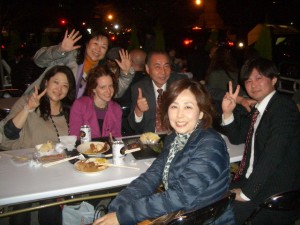
In the meantime, Pam and Jon had been attending a wedding in Nagoya and had also visited Mikawa Junior High School. Mikawa has been the sister school of Ulladulla High School for 16 years. Pam met the students who would visit Ulladulla High School in May this year, and felt very much a part of the staff—she was shown photos of one staff member’s wedding and other photos of babies born a few weeks previously to two other staff members. She had a lovely dinner with all the staff that evening.
Pam also visited Okazaki Johsei High School, where she gave a presentation to the students about what they might expect if they are lucky enough to come on an ARET tour to Wollongong. That night she went out to a very nice dinner with some of the Okazaki staff and the principal.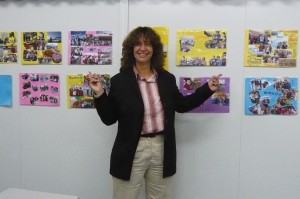
Pam and Jon attended the wedding of Mina and Yōta (Mina was one of the last official Pam Sensei teachers). It was a fun and very well-organised wedding. Start saving for a wedding present because Pam managed to be the one whose string was tied to the bride’s bouquet…!
Pam and Jon arrived in Tokyo a few days later where we were reunited. We met with Shimada san and Yamamoto san from Asahi Travel at Kosei Gakuen Junior High School, which is a boys’ school that had visited Keira High school the previous year. This year, they are going to visit the Illawarra Christian School instead. We met new staff and re-introduced ourselves to others, who were delighted to see us. Pam put on her clown hat and played the fool for a couple of English classes – one of her many skills. Some of the students, having visited Wollongong the previous year, recognised Pam and were very surprised and excited to see her!
That night, we were treated by Shimada-san’s boss to a lovely tempura dinner in Shinjuku. I think it’s safe to say that none of us had a bad meal in Japan—in fact, I’m pretty sure I came home a couple of kilos heavier. 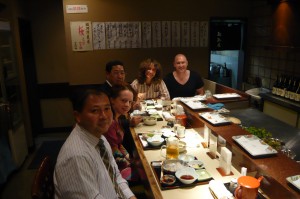
The following day we made our way to Dokkyo University, where we met with Ninomiya san and Goto san from the International Center. Not much time had passed since the 2012 Dokkyo University visit to Wollongong in February so the trip was still fresh in o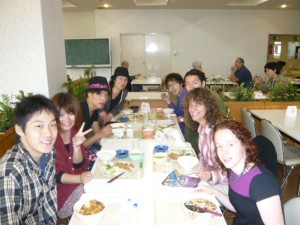 ur minds. After our business meeting, it was time to relax over lunch at the cafeteria with some of the students from 2012 trip.
ur minds. After our business meeting, it was time to relax over lunch at the cafeteria with some of the students from 2012 trip.
On our last night in Tokyo we went our separate ways and dined with respective friends.The following day we made our way to Ikebukuro, where the STA Tokyo branch is located. It was nice to finally put a face to a name—Okumura san was warm and inviting and even had a great idea for a new special interest market!
Jon, Pam and I were thoroughly sick of the sight of each other by this stage, but we managed to find our way from Shinjuku to Narita airport (on the bus) without homicidal incident. By some miracle, and despite some serious shopping action on my part, our cumulative luggage was lighter than it had been on our way over. Regardless, Pam decided to carry the most enormous plastic bag you have ever seen, full of senbei, on to the plane as hand luggage.
We had a five hour stopover in Cairns, which turned out to be lovely. We caught a taxi to the esplanade and had a nice brekky overlooking the beautiful ocean. 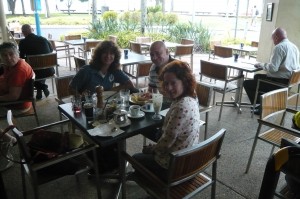 It was pretty muggy and I had some bad yoghurt that required me to abandon our walk and curl into the foetal position for a nap on the boardwalk. But other than that, we survived to make it back to Cairns airport in time for the last leg of our journey.
It was pretty muggy and I had some bad yoghurt that required me to abandon our walk and curl into the foetal position for a nap on the boardwalk. But other than that, we survived to make it back to Cairns airport in time for the last leg of our journey.
Pam’s senbei made it back intact and are slowly but surely disappearing.




